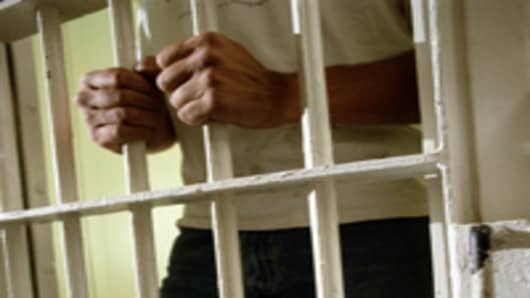You are woken up every morning at 6:00 sharp.
No rolling over and catching a few extra minutes of sleep. The lights are on, bright and unrelenting, and you can't turn them off.
You could use the extra sleep, though, because you never — ever — get a good eight hours. Every night, without fail, you are awakened at midnight, 3:00 a.m. and 5:00 a.m. Every single night.
But there is no time to dwell on that this morning, or any morning.
You have exactly 90 minutes to shower, get dressed, make your bed — no, you can't let that go for today, or any day for that matter — get some breakfast and get to your job, where the most you will ever hope to make is $1.15 an hour.
Welcome to life at the Federal Correctional Institution at Sandstone, the low-security federal prison in Northern Minnesota where Marc Dreier is serving a 20-year sentence for conspiracy, fraud and money laundering. (Read More: Diary of a Scam: The Fall of Power Attorney Marc Dreier.)
While many people believe convicted white collar criminals are condemned to nothing worse than being locked up in a "country club," the fact is that there really is no such thing. On a good day, an inmate's day is pure drudgery. The morning routine described above is just the start. As one white collar federal inmate described it to me once, nothing about your life is your own anymore. Perhaps that is a small price to pay society for the damage financial fraud can cause. Cry me a river, you are probably saying, and you are right.
But for these individuals, who once dwelled in the highest of high society, stood on the top rung of the corporate ladder and enjoyed the adulation of everyone around them, prison is a formidable punishment indeed. (Read More: The Best Places to Go to Prison.)
In more than three decades covering the criminal justice system, I have made quite a few trips to prison. I have visited and interviewed inmates, and toured a wide variety of facilities for our 2011 CNBC Original documentary "Billions Behind Bars: Inside America's Prison Industry." It seems each visit takes one through a familiar thought process.
Even for a visitor, entering a prison means giving up some of your freedom.
Your cell phone stays in the car. You can't bring it inside. Your belt, your wallet, your car keys will likely be left with the guards. No paper or pens unless you are the inmate's attorney or a reporter conducting a pre-approved interview. You are limited to the clothes on your back (as long as they are not khaki, the color of prison uniforms) and perhaps a small amount of cash to use in the vending machines.
Once inside, you can't help but imagine — if only for a moment — what it would be like to live there. There is no such thing as privacy. You live with the same inmates and guards, day in and day out. You can watch some television and maybe use the Internet, but it is tightly controlled. There may be a library, but the selection is laughable.
Physically, these places are stark and depressing. Cinder block walls, concrete floors, fluorescent light. The bars and the razor wire and the massive locks on the doors are constant reminders that you won't be leaving until the guards say you can.
As a visitor, you can keep reminding yourself that it will be over soon and you will be back to freedom. An inmate doesn't have that luxury.
And when your visit is over and you finally walk out the front door, you invariably take in a very deep breath and are very happy to be free once again. You are very thankful not to be in the heavy prison shoes of the person you just visited.
Prison inmates can at least look forward to visits from family and friends, but visiting hours are generally limited to a few hours a week and a set number of visits per inmate every month. Visits from even the closest relatives and friends tend to taper off anyway, in part because of the ordeal the visitor must go through, and because prisons by their nature are remote and difficult to get to.
In the documentary "Unraveled," Marc Dreier and his lead defense attorney, Gerald Shargel, spend a great deal of time trying to strike the right tone in appealing to U.S. District Judge Jed Rakoff for a sentence lighter than the 145 years prosecutors wanted.
This is not just for the obvious reason of shortening his prison sentence— as a 60-year-old man (now 62), Dreier stands a decent chance of dying in prison anyway. But the length of the sentence also helps determine the type of facility where convicts are sent.
Dreier's 20-year sentence allowed him to serve his time at a low-security prison like Sandstone. U.S. Bureau of Prisons policy generally requires that inmates with longer sentences serve their time at a higher-security facility. For example, Bernard Madoff, sentenced a few weeks before Dreier to 150 years in prison, is serving his time at a medium-security facility in North Carolina. (Read More: Bernard Madoff's Life Behind Bars.)
Some of the differences between low and medium security are subtle — both types of institutions are heavily fortified and regimented. But instead of traditional prison cells, inmates in low-security prisons live in the equivalent of dorm rooms or cubicles with dressers and desks and bunk beds (the inmate with more seniority gets the bottom bunk).
The basic lack of freedom is the same, however. Among the constant reminders are the regular inmate counts — at all hours of the day and night, including 3:00 a.m. — during which guards are required to verify that every inmate is there, in the flesh.
Like his fellow inmates, Dreier is expected to keep his living area clean and neat, and to keep himself groomed. There is a barbershop on site, closed Mondays.
If he saves up enough money from his job, or if family or friends deposit some funds into his prison account, he can go shopping at the prison commissary. Various types of snacks and beverages are available, or he can splurge and buy himself a new watch. It's hardly the Rolexes he once favored, however. A Casio G-Shock digital watch — the most expensive item on sale — will set him back $76.70.
Sandstone does offer inmates some opportunities to relax. There is even a sunbathing area, though it is still a far cry from the "Club Fed" of popular lore. That's because here in Northern Minnesota, the average high temperature only hits sunbathing levels roughly one month out of the year.
There is no such thing as parole in the federal prison system. The best Dreier can hope for is a couple of years off for good behavior.
He is currently scheduled for release in November 2026, six months after his 76th birthday. If he lives that long, it may be the next time he gets a decent night's sleep.
Tune in:
"Unraveled" premieres Thursday, November 8th at 9 p.m. | 12 a.m. ET.




